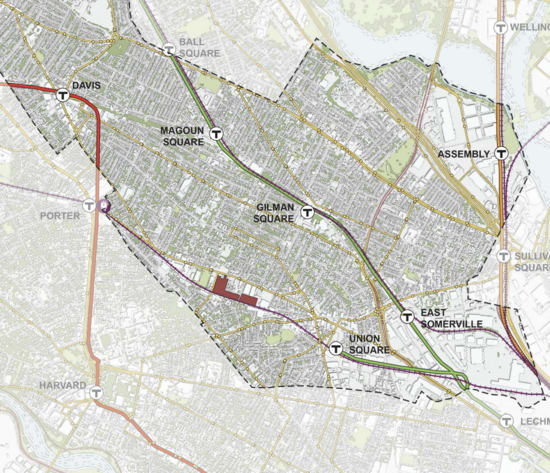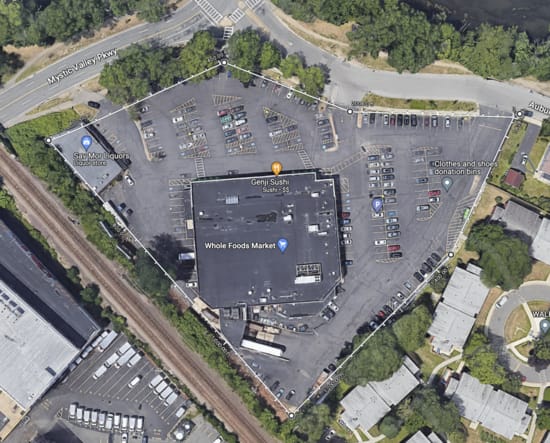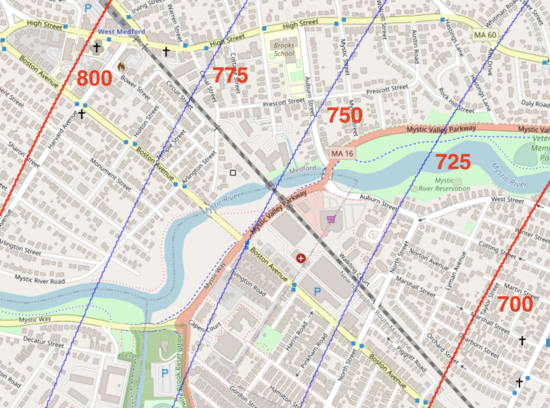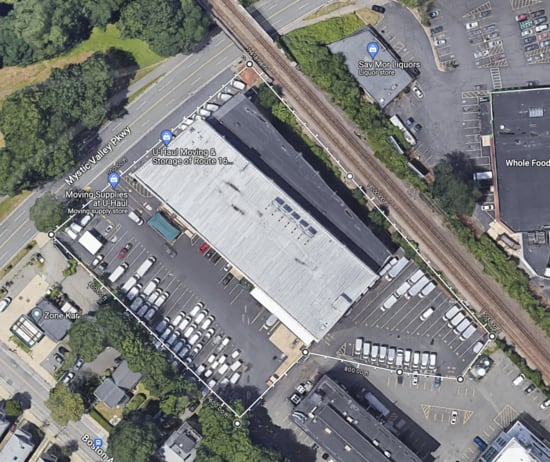Fund Transit With Development
12mako yass
14jefftk
7mako yass
1TeaTieAndHat
2mako yass
2mako yass
5gwern
3TeaTieAndHat
1TeaTieAndHat
2mecko23
4mecko23
1Thomas Sepulchre
4Ben
2jefftk
1Thomas Sepulchre
2jefftk
1Thomas Sepulchre
2Ben
2jefftk
1Thomas Sepulchre
2jefftk
1jp
New Comment
A land value tax would solve this ;-;
Yet another reminder that there's no justice in the system where land value is captured by the owner, because the value of the land is effectively never created by the owner of the land, but instead by adjacent projects and public infrastructure.
But I'm describing exactly the sort of exceptional situation where the owner is changing the value of the land. If you buy land and then pay the local transit agency to build transit to it, your land (and all surrounding land) becomes more valuable.
(And so an ideal version of a land value tax would go up for your neighbors, who didn't cause the value increase, but not for you)
Yeah it would be cool if residents of an area could simply come together and make their own decisions about what could raise the value of the entire region without being punished by an increase LVT to a government who did not think to do these things. But I think that process of coming together to do things is what a local government is supposed to be.
I dunno. I'm starting to think that the very american assumption that public and private are supposed to be separate worlds that don't influence each other is actually disgustingly wrong.
All goods have both public and private components. So maybe the land taxes of any new installation should factor both of these things. When you benefit from the surroundings, you should pay, when you contribute, you should be paid back. Maybe LVT should be further generalized: The labors that we know you are quietly benefiting from, you must pay towards them.
(Imagine a ministry of aesthetics who pay a basic sum to beautiful buildings, who don't strictly block the creation of ugly buildings but do impose an ongoing cost. Imagine those incentives applied consistently over an entire city for decades.)
Very wrong assumption indeed, but not (no longer? or never?) typically American by any means. Also maybe it is a necessary wrong assumption? How do you merge public and private without rendering either word meaningless, in practice?
You make it a continuum. The degree to which a project is an excludable good, or to which its importance is only legible to its customers, is its privateness.
I think justice is essentially a perfect negotiation outcome.
Considering transitioning to a view where, of course, you can't attain perfect things, so you don't have to be mad all of the time about imperfect justice.
It would be worth looking at the successful Japanese, Hong Kong, and London case-studies of transit agencies owning land around their transport (and perhaps NYC's Penn Station & Madison Square Garden as the anti-case-study).
Just to quickly point out that it has happened before! In the 1920s, when London was building its Metropolitan Line, the company that managed it had obtained the right to keep surplus land (when they have to kick you out and buy your farm, the government allowed them to keep the farm, not just the small fraction actually occupied by the tracks and stations), and they also deliberately bought land near planned extensions. It got them enough money to pay a dividend for most of their operating years. https://en.wikipedia.org/wiki/Metro-land
But I think it would be significantly harder to achieve in other contexts: will people sell you the land for cheap if you tell them it’s because you want to build a metro line on it and make a lot of profit by developing the land? Or will they just factor the proximity to the future transit line into the price?
Not to mention that (I assume) transit companies are no good at building and selling houses, so they’d have to partner with developers, who would probably think they could have done it all on their own without the transit company folks who take all the profits?
Armchair Transit Enthusiast here! Hopefully I can share some of my understanding on the situation. In short I think you've hit most of the answer in your last paragraph.
As background for those new to the topic (which it OP seems to know most of this already), this was actually how large swaths of pre-WW1 cities were developed and that method has largely disappeared by car-centric development that we've see explode post-WW2. I'm sure there are a variety of different reasons for this but if acceptable I can put a few of them in a quick list (willing to expand upon it if there is interest).
-
Governmental City Planning favoring cars the advantage-it was simply the zeitgeist for 60 years, lower (apparent) cost and perhaps some corruption (there is some evidence of a "automobile lobby" going for regulatory capture route)
-
Federal Government subsiding car infrastructure for defense encourages secondary development taking advantage of the new infrastructure.
-
Perceived market preference for car based development
-
Lower investment cost of non-transit development (dense=expensive and less dense development favors decentralized vs centralized transit)
-
Increase in governmental outreach and inclusion of affected voices- Overall good yes, but does come with a notable increase in costs and project timelines There still exists
However, there still are projects being built in this method though! Notably, Brightline East and West with the more important link being this, which is the parent company developing the adjacent real estate. I think time will show if these projects are initially successful, then we will see further interest and attempts being made.
And now for the low effort response to OPs question:
"Are cities unwilling to agree to high density for newly transit-served locations?"
Absolutely, though not the "City" per se but a large enough minority of citizens to make it exceedingly difficult. Time, and time again during the outreach phase of development there are always backlashes from citizens which make it very difficult to get ANY density built in cities. This pressures governmental officials which then result in needing project reworks to get approval, which still are not good enough for the concerned citizens, etc etc etc, ad nauseam. All of this balloons cost and timelines.
"Are the costs too unpredictable?"
Kinda, but I would say its just far to more capital intensive. First land purchasing costs, which key here is that not only is it a large track of land but also large tracts that are contiguous. Then once you start needing to get planning permission of right of way from Federal, State DOTs and local officials, trying to get everyone on board can take years. Then you have to deal with the hellscape of up-zoning and getting approval/permits (see below). All the while you better hope no environmentalist decides your transit route is gonna intersect a wildlife corridor and takes up the noble lawsuit fight (okay my bias is bleeding though a little). See next for the tie together.
"Are private developers too car-focused?"
Yes, but I would say not because they are ignorant but rather inexperienced. Think of how much new/different expertise is needed here in the way of engineering and legal. There simply is no experience or latent knowledge even in planning, hiring, and working with experts in the respective fields. This combined with the heavy investment needed and the few data points in recent decades make this a hard sell to decision makers.
The idea is, the public transit company buys property, makes it much more valuable by building service to it, and then sells it.
This plan is unrealistic because it assumes that the owner won't price the future value in.
Assume you try to do exactly that. Why would the current owner sell the land and the historic price when, in fact, it is very clear that the price will go up once you are done with your project? No, the owner won't sell below the anticipated value of the land, or at least a substantial fraction of it.
I think this argument is wrong. If they don't sell there is no train (at least not to that exact place), so they gain nothing by pricing the project out of existence or driving it elsewhere.
I want to build a Disneyland resort. There are dozens of different sites I could put it. When I go to a landowner (eg. a farmer) to buy land for my resort they can't sell it at the value it would have if it were a disneyland, if they try that I drive 10 mins up the road to the next farmer, and eventually one of them will realise that selling the land for a little more than its currently worth to them as a farm is still profit.
This example is no different. If their is one, and only one, place the train could possibly go then yes the person on that land can charge you quite a lot. But still not 100% of what the land will be worth after the train is there, a potential train connection that someone might build in the future is worth a lot less than an actual train connection now. But, realistically, there will be other options for where to put trains and stations. So the owners of the half-dozen best sites have to try and make better (lower) offers than one another.
"Why would the current owner sell the land at the historic price when, in fact, it is very clear that the price will go up once you are done with your project?" --- "Why would anyone sell you steel at the market price of steel, when, in fact, it is very clear that the value will go once you are done turning it into an airplane?"
There's lots of land that could have transit built to it, but won't unless someone does. The two specific projects I gave as examples are unusual in that they are atypically good fits for transit expansion, but this general approach makes a lot of sense even if you give that up. And has lots of historical precedent.
This is a bit like saying no one would sell rural land cheaply to be used for a charter city because once the city is built that land would be really valuable, ignoring that there are many sites a potential charter city builder can choose among.
I don't see your point. If you are saying that there are many nearby sites for transit expansion, then the owner of the land should not sell at a low price, because if any of those sites is chosen, the land value will go up.
If you are saying that there are many alternative sites across the country, then this is not relevant. Those projects aren't mutually exclusive.
We have to keep in mind that the land owner will not profit from the project being completed once the land is sold, they will only profit from the sale itself. The rational move is either to keep the land in case a project goes through, or sell it at the future price because selling means giving up on potential future profit of the project going through.
I'm not trying to say that the possibility of increased density via transit has no effect on land values relative to today: I agree the possibility of transit raises land values. My claim is that it doesn't raise land values very much.
But it also sounds to me like you're giving a mistaken framework for how to value things where there are many different amounts they could be worth in the future? I would propose using expected value: value the land in proportion to how much it would be worth in all of these different potential futures, scaled by their probability.
Ok, let's stick to this notion of expected value because it plays both for the land owner and for the transit system builder.
To get back to your post, the plan was to buy an area, build a transit system in the middle of it, then sell the rest at a higher price. If you fail to buy all the land you need (or at least enough of it), you may give up on the project, in which case the value of the land does not increase. So indeed, as the transit system builder, the viability of your project (and the profit attached to it) is linked to the probability that you indeed acquire the land you need (both the land to physically build the transit system and the land around to sell later at a higher price), as well as the price at which you will be able to buy the land first, and re-sell it after completion.
Now, if the land owner are correctly calibrated, and they correctly anticipate the odds of your project being a success, your expected profit on the sale of the land must be zero.
If, on the flip side, you expect to make a profit because the land owners will underestimate your ability to succeed, will not see you coming, not understand what you are trying to do, or something along those lines, then your strategy relies on the market not being efficient. If this is the case, I think this is a crux.
"Now, if the land owner are correctly calibrated, and they correctly anticipate the odds of your project being a success, your expected profit on the sale of the land must be zero."
I worry that this argument appears to apply to any business venture at all that involves buying land. Indeed, it applies to any business venture at all that involves buying anything. But, many people seem to think that projects that involve purchasing goods or services can in fact be profitable.
Goods (such as steel or land) can be improved by turning the steel into a plane, or adding a train connection to the land. Your model seems to be roughly that the current owner works out the chances that someone will buy the steel or land and turn it into a plane, or add a train connection, and then they price with that chance in mind. The problem (I think) is that their is causal connection between the price and the process of it turning into the imagined end product. If you charge extra for your steel because you think it will turn into a plane, then it won't, because Boing will just buy steel from someone else and turn that into a plane instead of yours.
This doesn't sound right to me. Let's take a very simplified situation.
- Imagine there are several identical places where I'm considering buying a bunch of land and then building transit there to make it more valuable.
- The value of land if this option were removed is
- The value of land after I build transit to it is
I get all the land owners together and we have an auction, where I offer to buy from whichever owner gives me the best price, wouldn't you expect to end up with a price much closer to than ?
In a real scenario properties wouldn't be identical which makes an auction a poor fit and it wouldn't look exactly like this, but it doesn't seem that far off?
Now, you might say that is actually quite high, nearly or exactly as high as because these land owners could sell to someone else who also has a "buy land, build transit" approach. Then I agree there's no profit, but that's a standard result in economics: under perfect competition economic profits are zero.



